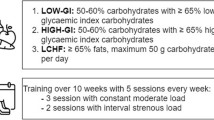Abstract
Continuous high glycemic load and inactivity challenge glucose homeostasis and fat oxidation. Hyperglycemia and high intramuscular glucose levels mediate insulin resistance, a precursor state of type 2 diabetes. The aim was to investigate whether a carbohydrate (CHO)-reduced diet combined with high-intensity interval training (HIIT) enhances the beneficial effects of the diet alone on insulin sensitivity and fat oxidation in obese individuals. Nineteen obese subjects underwent 14 days of CHO-reduced and energy-restricted diet. Ten of them combined the diet with HIIT (4 min bouts at 90% VO2peak up to 10 times, 3 times a week). Oral glucose insulin sensitivity (OGIS) increased significantly in both groups; [diet–exercise (DE) group: pre 377 ± 70, post 396 ± 68 mL min−1 m−2; diet (D) group: pre 365 ± 91, post 404 ± 87 mL min−1 m−2; P < 0.001]. Fasting respiratory exchange ratio (RER) decreased significantly in both groups (DE group: pre 0.91 ± 0.06, post 0.88 ± 0.06; D group: pre 0.92 ± 0.07, post 0.86 ± 0.07; P = 0.002). VO2peak increased significantly in the DE group (pre 27 ± 5, post 32 ± 6 mL kg−1 min−1; P < 0.001), but not in the D group (pre 26 ± 9, post 26 ± 8 mL kg−1 min−1). Lean mass and resistin were preserved only in the DE group (P < 0.05). Fourteen days of CHO-reduced diet improved OGIS and fat oxidation (RER) in obese subjects. The energy-balanced HIIT did not further enhance these parameters, but increased aerobic capacity (VO2peak) and preserved lean mass and resistin.




Similar content being viewed by others
References
Accurso A, Bernstein RK, Dahlqvist A, Draznin B, Feinman RD, Fine EJ, Gleed A, Jacobs DB, Larson G, Lustig RH, Manninen AH, McFarlane SI, Morrison K, Nielsen JV, Ravnskov U, Roth KS, Silvestre R, Sowers JR, Sundberg R, Volek JS, Westman EC, Wood RJ, Wortman J, Vernon MC (2008) Dietary carbohydrate restriction in type 2 diabetes mellitus and metabolic syndrome: time for a critical appraisal. Nutr Metab 5:9
Allison DB, Fontaine KR, Manson JE, Stevens J, VanItallie TB (1999) Annual deaths attributable to obesity in the United States. JAMA 282:1530–1538
Babraj JA, Vollaard NB, Keast C, Guppy FM, Cottrell G, Timmons JA (2009) Extremely short duration high intensity interval training substantially improves insulin action in young healthy males. BMC Endocr Disord 9:3
Bjorntorp P (1991) Metabolic implications of body fat distribution. Diabetes Care 14:1132–1143
Black SE, Mitchell E, Freedson PS, Chipkin SR, Braun B (2005) Improved insulin action following short-term exercise training: role of energy and carbohydrate balance. J Appl Physiol 99:2285–2293
Brand-Miller JC, Holt SH, Pawlak DB, McMillan J (2002) Glycemic index and obesity. Am J Clin Nutr 76:281S–285S
Brehm BJ, Seeley RJ, Daniels SR, D’Alessio DA (2003) A randomized trial comparing a very low carbohydrate diet and a calorie-restricted low fat diet on body weight and cardiovascular risk factors in healthy women. J Clin Endocrinol Metab 88:1617–1623
Chaston TB, Dixon JB, O’Brien PE (2007) Changes in fat-free mass during significant weight loss: a systematic review. Int J Obes (Lond) 31:743–750
Cordain L, Eaton SB, Sebastian A, Mann N, Lindeberg S, Watkins BA, O’Keefe JH, Brand-Miller J (2005) Origins and evolution of the Western diet: health implications for the 21st century. Am J Clin Nutr 81:341–354
Criswell D, Powers S, Dodd S, Lawler J, Edwards W, Renshler K, Grinton S (1993) High intensity training-induced changes in skeletal muscle antioxidant enzyme activity. Med Sci Sports Exerc 25:1135–1140
da Rocha EE, Alves VG, da Fonseca RB (2006) Indirect calorimetry: methodology, instruments and clinical application. Curr Opin Clin Nutr Metab Care 9:247–256
Dansinger ML, Gleason JA, Griffith JL, Selker HP, Schaefer EJ (2005) Comparison of the Atkins, Ornish, weight watchers, and zone diets for weight loss and heart disease risk reduction: a randomized trial. JAMA 293:43–53
Diamond J (2003) The double puzzle of diabetes. Nature 423:599–602
Elia M, Stratton R, Stubbs J (2003) Techniques for the study of energy balance in man. Proc Nutr Soc 62:529–537
Fell RD, Terblanche SE, Ivy JL, Young JC, Holloszy JO (1982) Effect of muscle glycogen content on glucose uptake following exercise. J Appl Physiol 52:434–437
Filkova M, Haluzik M, Gay S, Senolt L (2009) The role of resistin as a regulator of inflammation: implications for various human pathologies. Clin Immunol 133:157–170
Friedman JM, Halaas JL (1998) Leptin and the regulation of body weight in mammals. Nature 395:763–770
Garg A, Bonanome A, Grundy SM, Zhang ZJ, Unger RH (1988) Comparison of a high-carbohydrate diet with a high-monounsaturated-fat diet in patients with non-insulin-dependent diabetes mellitus. N Engl J Med 319:829–834
Gibson R (1993) Nutritional assessment. A laboratory manual. Oxford University Press, New York
Grediagin A, Cody M, Rupp J, Benardot D, Shern R (1995) Exercise intensity does not effect body composition change in untrained, moderately overfat women. J Am Diet Assoc 95:661–665
Hanke N, Meissner JD, Scheibe RJ, Endeward V, Gros G, Kubis HP (2008) Metabolic transformation of rabbit skeletal muscle cells in primary culture in response to low glucose. Biochim Biophys Acta 1783:813–825
Hansen AK, Fischer CP, Plomgaard P, Andersen JL, Saltin B, Pedersen BK (2005) Skeletal muscle adaptation: training twice every second day vs. training once daily. J Appl Physiol 98:93–99
Hession M, Rolland C, Kulkarni U, Wise A, Broom J (2009) Systematic review of randomized controlled trials of low-carbohydrate vs low-fat/low-calorie diets in the management of obesity and its comorbidities. Obes Rev 10:36–50
Kadoglou NP, Perrea D, Iliadis F, Angelopoulou N, Liapis C, Alevizos M (2007) Exercise reduces resistin and inflammatory cytokines in patients with type 2 diabetes. Diabetes Care 30:719–721
Katz LD, Glickman MG, Rapoport S, Ferrannini E, DeFronzo RA (1983) Splanchnic and peripheral disposal of oral glucose in man. Diabetes 32:675–679
Kelley DE, Mandarino LJ (1990) Hyperglycemia normalizes insulin-stimulated skeletal muscle glucose oxidation and storage in noninsulin-dependent diabetes mellitus. J Clin Invest 86:1999–2007
Kelley DE, Goodpaster B, Wing RR, Simoneau JA (1999) Skeletal muscle fatty acid metabolism in association with insulin resistance, obesity, and weight loss. Am J Physiol 277:E1130–E1141
Lindstrom J, Louheranta A, Mannelin M, Rastas M, Salminen V, Eriksson J, Uusitupa M, Tuomilehto J (2003) The Finnish Diabetes Prevention Study (DPS): lifestyle intervention and 3-year results on diet and physical activity. Diabetes Care 26:3230–3236
MacDougall JD, Ward GR, Sutton JR (1977) Muscle glycogen repletion after high-intensity intermittent exercise. J Appl Physiol 42:129–132
Manson JE, Nathan DM, Krolewski AS, Stampfer MJ, Willett WC, Hennekens CH (1992) A prospective study of exercise and incidence of diabetes among US male physicians. JAMA 268:63–67
Mari A, Pacini G, Murphy E, Ludvik B, Nolan JJ (2001) A model-based method for assessing insulin sensitivity from the oral glucose tolerance test. Diabetes Care 24:539–548
Martin BC, Warram JH, Krolewski AS, Bergman RN, Soeldner JS, Kahn CR (1992) Role of glucose and insulin resistance in development of type 2 diabetes mellitus: results of a 25-year follow-up study. Lancet 340:925–929
Morton JP, Croft L, Bartlett JD, Maclaren DP, Reilly T, Evans L, McArdle A, Drust B (2009) Reduced carbohydrate availability does not modulate training-induced heat shock protein adaptations but does upregulate oxidative enzyme activity in human skeletal muscle. J Appl Physiol 106:1513–1521
Nielsen JV, Joensson E (2006) Low-carbohydrate diet in type 2 diabetes. Stable improvement of bodyweight and glycemic control during 22 months follow-up. Nutr Metab (Lond) 3:22
Nikitin YP, Klochkova E, Mamleeva FR (1991) Comparison of diets in two native Chukotka populations and prevalence of ischemic heart disease risk factors. Arctic Med Res 50:67–72
Nobmann ED, Mamleeva FY, Klachkova EV (1994) A comparison of the diets of Siberian Chukotka and Alaska Native adults and recommendations for improved nutrition, a survey of selected previous studies. Arctic Med Res 53:123–129
Ojuka EO (2004) Role of calcium and AMP kinase in the regulation of mitochondrial biogenesis and GLUT4 levels in muscle. Proc Nutr Soc 63:275–278
Parillo M, Rivellese AA, Ciardullo AV, Capaldo B, Giacco A, Genovese S, Riccardi G (1992) A high-monounsaturated-fat/low-carbohydrate diet improves peripheral insulin sensitivity in non-insulin-dependent diabetic patients. Metabolism 41:1373–1378
Richter EA, Derave W, Wojtaszewski JF (2001) Glucose, exercise and insulin: emerging concepts. J Physiol 535:313–322
Salmeron J, Ascherio A, Rimm EB, Colditz GA, Spiegelman D, Jenkins DJ, Stampfer MJ, Wing AL, Willett WC (1997) Dietary fiber, glycemic load, and risk of NIDDM in men. Diabetes Care 20:545–550
Samaha FF, Iqbal N, Seshadri P, Chicano KL, Daily DA, McGrory J, Williams T, Williams M, Gracely EJ, Stern L (2003) A low-carbohydrate as compared with a low-fat diet in severe obesity. N Engl J Med 348:2074–2081
Smith SR, de Jonge L, Zachwieja JJ, Roy H, Nguyen T, Rood JC, Windhauser MM, Bray GA (2000) Fat and carbohydrate balances during adaptation to a high-fat. Am J Clin Nutr 71:450–457
Storlien L, Oakes ND, Kelley DE (2004) Metabolic flexibility. Proc Nutr Soc 63:363–368
Talanian JL, Galloway SD, Heigenhauser GJ, Bonen A, Spriet LL (2007) Two weeks of high-intensity aerobic interval training increases the capacity for fat oxidation during exercise in women. J Appl Physiol 102:1439–1447
Tjonna AE, Lee SJ, Rognmo O, Stolen TO, Bye A, Haram PM, Loennechen JP, Al-Share QY, Skogvoll E, Slordahl SA, Kemi OJ, Najjar SM, Wisloff U (2008) Aerobic interval training versus continuous moderate exercise as a treatment for the metabolic syndrome: a pilot study. Circulation 118:346–354
Tomas E, Lin YS, Dagher Z, Saha A, Luo Z, Ido Y, Ruderman NB (2002) Hyperglycemia and insulin resistance: possible mechanisms. Ann N Y Acad Sci 967:43–51
Volek JS, Phinney SD, Forsythe CE, Quann EE, Wood RJ, Puglisi MJ, Kraemer WJ, Bibus DM, Fernandez ML, Feinman RD (2009) Carbohydrate restriction has a more favorable impact on the metabolic syndrome than a low fat diet. Lipids 44:297–309
Wallace RB, Anderson RA (1987) Blood lipids, lipid-related measures, and the risk of atherosclerotic cardiovascular disease. Epidemiol Rev 9:95–119
Westman EC, Feinman RD, Mavropoulos JC, Vernon MC, Volek JS, Wortman JA, Yancy WS, Phinney SD (2007) Low-carbohydrate nutrition and metabolism. Am J Clin Nutr 86:276–284
WHO (1999) Definition, diagnosis and classification of diabetes mellitus and its complications, report of a WHO consultation. World Health Organization, Geneva, p 48
Yeo WK, Lessard SJ, Chen ZP, Garnham AP, Burke LM, Rivas DA, Kemp BE, Hawley JA (2008) Fat adaptation followed by carbohydrate restoration increases AMPK activity in skeletal muscle from trained humans. J Appl Physiol 105:1519–1526
Yki-Jarvinen H, Helve E, Koivisto VA (1987) Hyperglycemia decreases glucose uptake in type I diabetes. Diabetes 36:892–896
Zierath JR, Galuska D, Nolte LA, Thorne A, Kristensen JS, Wallberg-Henriksson H (1994) Effects of glycaemia on glucose transport in isolated skeletal muscle from patients with NIDDM: in vitro reversal of muscular insulin resistance. Diabetologia 37:270–277
Acknowledgments
This work was supported by a North West Wales NHS Research Grant. The authors must thank Dr. Anthony Wilton and Dr. Peter Carson from Gwynedd Hospital for their helpful collaboration. We acknowledge Mr. Kevin Williams for his precious technical support. Finally, we are grateful to Dr. Thomas Caspari for letting us use part of the North West Cancer Research Fund Institute facilities.
Author information
Authors and Affiliations
Corresponding author
Additional information
Communicated by Jacques Poortmans.
Rights and permissions
About this article
Cite this article
Sartor, F., de Morree, H.M., Matschke, V. et al. High-intensity exercise and carbohydrate-reduced energy-restricted diet in obese individuals. Eur J Appl Physiol 110, 893–903 (2010). https://doi.org/10.1007/s00421-010-1571-y
Accepted:
Published:
Issue Date:
DOI: https://doi.org/10.1007/s00421-010-1571-y




